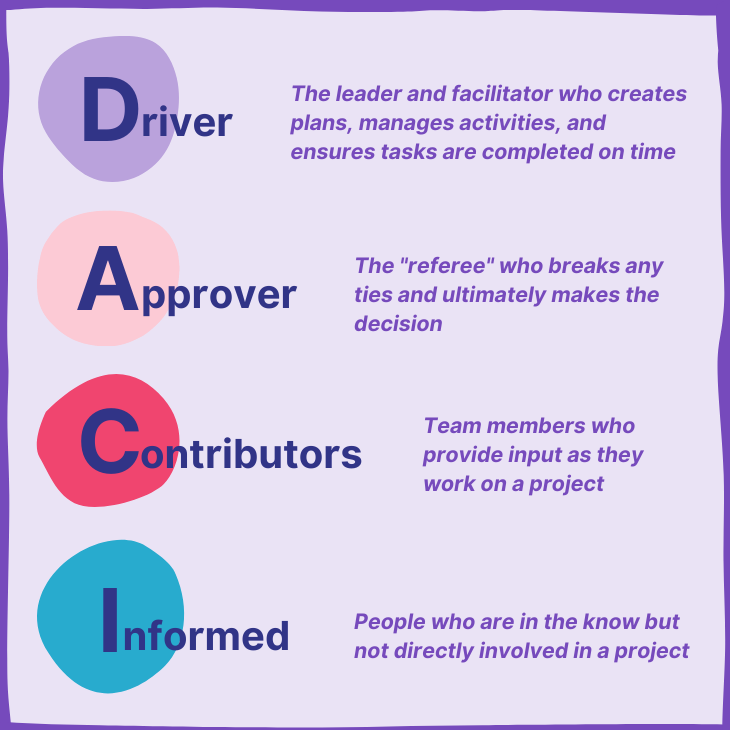Editor’s note: This article was last updated on 31 May 2023 to add examples of scenarios where the DACI framework would be particularly valuable to aid in decision-making, as well as a simple template to use as a staring point when implementing DACI in your organization.

Effective decision-making is crucial to the success of any project or team. DACI is a powerful decision-making framework designed to clarify roles and responsibilities, ultimately improving the efficiency and clarity of projects.
In this guide, we’ll define what DACI is, explore the four DACI roles in detail, and provide real-world examples and templates to help you implement the framework in your organization.
DACI (pronounced “day-see”) is a decision-making framework for agile, cross-functional groups designed to clarify expectations around roles and responsibilities. The DACI framework is specifically designed to improve efficiency and clarity in projects and teams, fostering a more streamlined approach to decision-making.
Think of DACI as a map of how different people contribute to a project.
The acronym “DACI” represents the four key roles in this model: driver, approver, contributors, and informed. These roles are often visualized in a matrix or quadrant-type chart.
That said, the format doesn’t necessarily matter; a document that puts names to the DACI functions and tracks decisions will work great. The best format is whatever people around you are most likely read and use.
The DACI framework includes four key roles:
The order of the roles in the acronym is sorted from fewest to broadest. It’s generally agreed that the driver should be one person. The approver is ideally one person but, depending on the scope and complexity of the project or organization, it may be necessary to have multiple approvers. Keep approvers to as few as needed for decision-making efficiency and quality.
More people are welcome to participate as contributors, and the informed can be an even larger audience within the company. Although the roles should be set for the entire project or group, roles can also be set for specific tasks or subtasks.
Now let’s take a more detailed look at the four roles of the DACI framework:

The driver is the leader and facilitator. They are responsible for creating the plan, managing activities, setting timelines, and making sure tasks are completed.
The driver is probably doing the most documentation and communication of anyone involved in the decision-making process. The driver is not the only one doing work, but they are the person ensuring progress doesn’t stall and that any next steps are clear to everyone else involved.
The approver is the decision-maker. Like a referee in a game, they make the call and break any ties.
The approver doesn’t have to provide input on every detail (unless they want to), but they should be informed enough to make good decisions. The driver should ensure the approver has enough context and information to do so.
Contributors are the team members providing input, and possibly work, on a project. They should be proactively offering their expertise, not waiting for the driver to pull them in.
Team members should consider themselves co-owners of the final decision, not just people who were asked to weigh in.
The informed are the people who need to know about the project or decision but don’t have direct authority over it. They receive updates but are not active participants in the project or decision.
The driver should be proactive in communicating progress and outcomes to them.
The DACI framework was originally developed at the software company Intuit during the 1980s. The model was designed to make group decision-making faster and more effective by assigning these specific roles to team members, which helps to establish clear lines of responsibility, lending authority to certain members of the group, reducing friction, and eliminating potential disagreements.
Since it was first used at Intuit 40 years ago, the DACI framework has since been adopted and adapted by many other companies. It was originally designed to help with product decision-making but has been used for many different types of decisions since then.
The DACI framework is best utilized in situations where clear decision-making roles and responsibilities need to be defined within a project or team. While it can be a valuable tool in any project setting, there are certain scenarios where the DACI framework shines more than in others.
Here are some examples of scenarios where applying DACI could be especially beneficial:
Consider, for example, the case of a multinational tech company launching a new product. A large team consisting of designers, developers, marketers, and strategists need to collaborate on the product’s creation, launch, and post-launch support. Implementing the DACI framework in such a scenario can ensure that everyone knows their roles and responsibilities and that decisions are made efficiently and effectively.
Another example could be a startup establishing a new cross-functional team to explore a new market or customer segment. With the DACI framework, each team member would know their role within the project, and decisions can be made quickly and decisively, ensuring that the team can respond to new information and adapt their approach as necessary.
By defining roles, the DACI framework brings clarity, aligns the team toward the common goal, and ensures the decision-making process is efficient, reducing delays and miscommunication.
To get started with using the DACI framework in your organization, you can use the following template. It includes space to record each role, the person or people assigned to that role, their responsibilities, and the decision-making authority that comes with it.
Feel free to modify this DACI template by inputting information in the Person(s), Responsibilities, and Decision-making authority columns to suit your specific needs and team structure:
| Role | Person(s) | Responsibilities | Decision-making authority |
|---|---|---|---|
| Driver | [Driver’s name] | Oversee the entire project, manage communication, and keep the project moving forward | Can make decisions about the day-to-day operations of the project |
| Approver | [Approver’s name] | Make final decisions on key project aspects | Has final authority on significant decisions related to the project |
| Contributor | [Contributors’ names] | Work on tasks and provide input on decisions | Can make decisions related to their specific tasks or areas of expertise, but major decisions are made by the Driver and Approver |
| Informed | [Informed’s names] | Stay updated on project progress and decisions | Does not have decision-making authority but should be kept informed of all major decisions and project progress |
You can also access a version of this DACI template on Google Sheets.
If you’re looking to dive a bit deeper, there are some other good DACI resources out there.
Here are some of the most practical DACI guides I’ve seen:
Critics of the DACI model claim that DACI isn’t for teams at all. The idea is that, if you were truly a team, then you wouldn’t need DACI. You’d simply align on an outcome and talk it out.
Building on that idea, some believe DACI fails to address the real problem. Alternatively, product managers should create an environment of psychological safety where people can be open about their opinions and disagreements. Hold any necessary debates and establish a decision-maker as the tie-breaker.
This has been my own personal experience in larger, more passionate product teams. The tie-breaker might be a head of product, VP, or director-level product leader. From there, it’s up to team members to be able to disagree and commit in support of the team.
If you’ve determined that DACI isn’t the right framework for your team, what alternative decision-making frameworks are out there?
DACI is often compared to RACI, another decision-making framework that stands for responsible, accountable, consulted, and informed. DACI evolved from RACI, but is more flexible and suited to agile environments.
DACI evolved from RACI, but even though they sound similar, they are very different in real-world applications.
In the case of RACI, R stands for responsible (instead of driver), and A stands for accountable (instead of approver). The C and I are essentially the same between the two models.
RACI was popular after World War II as big business was booming in the US. Organizations were very hierarchical with centralized decision-making. RACI has one person accountable for the successful completion of the work and emphasizes task completion over achieving valuable outcomes.
Today, in agile environments, we want teams to share accountability and ownership rather than individuals. RACI focuses on who to fire or promote depending on output, while DACI looks to make the best decisions and help teams work effectively.
You should never feel pressure to adopt one particular framework, no matter how popular it is. As you’ll see below, teams have adapted DACI and RACI for their own situations in many different ways.
Below is the complete list of DACI-related models. A subset of these is listed on Wikipedia with a bit more explanation if you want to explore more.
The DACI framework is an effective tool for driving clear and effective decision-making within teams and organizations. By designating roles and responsibilities and facilitating communication, DACI can help your team move forward confidently and cohesively on any project.
Whether you’re a startup looking to streamline your product decisions, or a larger organization working on complex projects, incorporating the DACI decision-making model can significantly enhance your team’s productivity and efficiency.
Featured image source: IconScout

LogRocket identifies friction points in the user experience so you can make informed decisions about product and design changes that must happen to hit your goals.
With LogRocket, you can understand the scope of the issues affecting your product and prioritize the changes that need to be made. LogRocket simplifies workflows by allowing Engineering, Product, UX, and Design teams to work from the same data as you, eliminating any confusion about what needs to be done.
Get your teams on the same page — try LogRocket today.

A practical framework for PMs to use AI in ideation without sacrificing judgment, strategy, or decision quality.

A practical five minute revenue estimation method to help product managers compare ideas, drop low impact features, and prioritize smarter.

A practical guide for PMs who want to stop being bottlenecks, delegate smarter, and lead teams effectively with a clear ownership framework.

Stop letting unreliable data block features. Treat data as inventory to track quality, ownership, and ship with confidence.